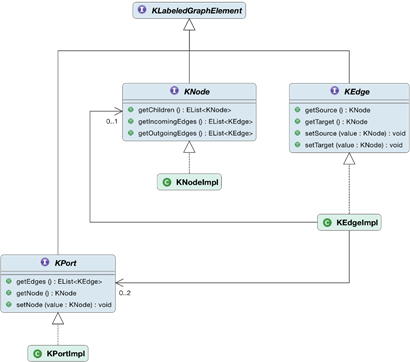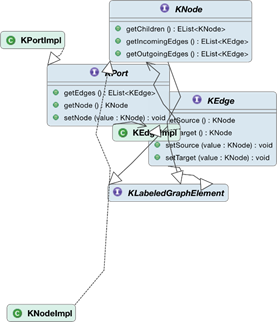2021/22 Layout
The purpose of this seminar is to independently scientifically work on a layout algorithm topic. The goal is to summarize the topic in an oral presentation and a written elaboration in form of a paper. Another purpose of this seminar is to practice working in structured and time-driven workflows (e.g. for conferences or workshops). Moreover, both of these aspects are good preparation for working on your thesis. We have many theses regarding these topics available; contact us if you are interested in that.
This seminar is a bachelor and master module at the same time. Compared to the bachelor seminar, we expect that master students include more related papers and therefore write a longer paper and hold a longer presentation (see below).


Imprtant Dates
Requirements | Wissenschaftliches Arbeiten von Prof. Peters |
|---|---|
Lecturers | Reinhard von Hanxleden (rvh@informatik.uni-kiel.de) |
Block seminar day | 29.01.22 |
Topics
You may choose one of the following papers from the different topics. The papers marked with a are the ones that we deemed more important.
The papers are assigned via first-come-first-serve. Already taken papers are crossed out. Many of the links do only work in the university network. If any problems occur feel free to contact us.
Aesthetics and Perception
Lloyd, Rodgers, and Roberts. "Metro map colour-coding: effect on usability in route tracing." In International conference on Theory and Application of Diagrams, pp. 411-428. Springer, 2018. PDF
Helen C. Purchase, Daniel Archambault, Stephen Kobourov, Martin Nöllenburg, Sergey Pupyrev, Hsiang-Yun Wu. "The Turing Test for Graph Drawing Algorithms". In Processings of the 28th International Symposium on Graph Drawing and Network Visualization (GD 2020), pp. 466-481. PDF
Burns, Carberry, Elzer, and Chester. "Automatically recognizing intended messages in grouped bar charts." In International Conference on Theory and Application of Diagrams, pp. 8-22. Springer, 2012. PDF
Human Computer Interaction
Pourali, Atlee. "A Focus+Context Approach to Alleviate Cognitive Challenges of Editing and Debugging UML Models." In ACM/IEEE 22nd International Conference on Model Driven Engineering Languages and Systems (MODELS), pp. 183–193. 2019. PDF
Frisch, Dachselt. "Off-Screen visualization techniques for class diagrams." In Proceedings of the 5th International Symposium on Software Visualization, pp. 163–172. 2010. PDF
Pietriga. "A Toolkit for Addressing HCI Issues in Visual Language Environments." In IEEE Symposium on Visual Languages and Human-Centric Computing (VL/HCC), pp.145–152. 2015. PDF
Green, Petre. "Usability Analysis of Visual Programming Environments - A Cognitive Dimensions Framework." In Journal of Visual Languages and Computing, pp. 131–174, Issue 7–2. 1996. PDF
Graph Drawing
(Master) Julien Walter, Johannes Zink, Joachim Baumeister, Alexander Wolff. "Layered Drawing of Undirected Graphs with Generalized Port Constraints". In Processings of the 28th International Symposium on Graph Drawing and Network Visualization (GD 2020), pp. 220-234. PDF
Chevalier and Safro. "Comparison of coarsening schemes for multilevel graph partitioning." In International Conference on Learning and Intelligent Optimization, pp. 191-205. Springer, 2009. PDF
Athenstädt, Hartmann, and Nöllenburg. "Simultaneous embeddability of two partitions." In International Symposium on Graph Drawing, pp. 64-75. Springer, 2014. PDF
Reyan Ahmed, Felice De Luca, Sabin Devkota, Stephen Kobourev, Mingwei Li. "Graph Drawing via Gradient Descent".In Processings of the 28th International Symposium on Graph Drawing and Network Visualization (GD 2020), pp. 3-17. PDF
Amyra Meidiana, Seok-Hee Hong, Peter Eades. "New Quality Metrics for Dynamic Graph Drawing". In Processings of the 28th International Symposium on Graph Drawing and Network Visualization (GD 2020), pp. 450-465. PDF
Euler Diagrams
Bottoni, Costagliola, and Fish. "Euler diagram encodings." In International Conference on Theory and Application of Diagrams, pp. 148-162. Springer, 2012. PDF
Chapman, Stapleton, Rodgers, Micallef, and Blake. "Visualizing sets: an empirical comparison of diagram types." In International Conference on Theory and Application of Diagrams, pp. 146-160. Springer, 2014. PDF
Other Types of Diagrams
Erwig and Smeltzer. "Variational Pictures." In International Conference on Theory and Application of Diagrams, pp. 55-70. Springer, 2018. Seite mit PDF
Schedule
Dates in the semester (currently not final)
Datum | Meilenstein |
|---|---|
Mo., 25.10., 23:59 | Deadline for topic |
Mo., 25.10., 12:00 | Kick-off |
Mo., 15.11., 23:59 | Deadline of the first draft in EasyChair |
In week of above, individual dates | Individual dates |
Mo., 13.12, 23:59 | Deadline of the first full version |
In week of above, individual dates | Individual dates |
Mo., 10.01., 23:59 | Deadline of the review version |
subsequently | Review assignment |
Mo., 17.01., 23:59 | Deadline reviews |
tbd | Talk on how to do talks/presentations (the talk-talk)? |
In the week of Mo., 10.01. | Individual dates for presentation slides |
Mo., 24.01., 23:59 | Deadline final version |
Sa. 29.1. | Presentations |
The Final Presentations
Currently, it is unclear how the talks will take place. This will be influenced by the development of the pandemic. We can think of recorded videos or a live conference or other alternatives. We expect to be able to make a decision at the beginning of January.
Schedule and Grading
Papers, Talks, Review
This seminar includes the creation of a paper, a talk, and two reviews.
Paper
The paper should provide an overview of the chosen topic. It should be written in a style that late bachelor student can understand it. The paper should be 6 (master) or 4 (bachelor) pages long, not more not less, and it should use the ACM LaTeX-style (more details below). We advise you to read the writing advice for writing a thesis.
Talk/Discussions
Your talk should be 40 minutes (master) or 25 minutes (bachelor) long. This is followed by 5 minutes of questions. The slides should contain page numbers to allow the participants to ask specific questions after the talk. It would be great to include a short tool demo if your topic includes some concrete implementation. You can freely choose your presentation tool. The talk can be held in English or German.
Your talk is followed by a discussion that should involve your fellow students (not just the lecturers). That means that you should also make an effort to get engaged in your fellow students' talks as well.
Review
A review consist of two parts:
- General comments (what do you like / not like regarding content, structure, and readability) as well as general suggestions to improve the paper
- In detail remarks and corrections
The first part of the review should be at least half an A4 page long. It should be written in full text and not only consist of notes. The review content should be similar to the review you get during the individual dates, however, it should be more in detail and with a clear focus on content, structure, and readability of the paper.
It is not possible to add files in the EasyChair review form. Therefore, it is not possible to add an annotated pdf as detailed correction.
The reviews are assigned after the review-version deadline and are based on the submitted version of the papers.
Grades
This seminar is graded. The grade is based on each milestone (the different versions of the paper, the reviews, the slides, the talk, your engagement in the discussion of other talks). For each milestone, quality and timeliness (see dates) are considered. If you miss deadlines, you may fail the seminar.
Technical Details
LaTeX
Your papers should be created using LaTeX and have to be in the ACM style. You can find all necessary files in this zip archive, including an example document that includes helpful LaTeX-hints to start with. Copy all files in some folder and begin to write your paper.
LaTeX can create a bibliography (it includes scientific publications, which are referenced to prove statements) too. The example includes a file named myrefs.bib, which holds the references. ACM provides a short overview with examples of bibliography entries.
While writing your paper keep the following in mind:
- Think about whether you want to write your paper in German or English and make use to use the corresponding ACM-style.
- Graphics from your original paper should not just be screenshotted and added to your paper. Ideally, you create your own graphic (ideally as a vector graphic) to have good quality graphics.
- A paper always consists of an introduction, at least one main chapter, and a conclusion.
EasyChair Tutorial
You can find our seminar in EasyChair here.
Ressources
In general, it is advised to look for related work in the university network since you will get access to many online libraries. We the following search engines and web pages:
- Google Scholar: http://scholar.google.de/
- dblp: http://dblp.uni-trier.de/
- CiteSeer: http://citeseer.ist.psu.edu/
- IEEE-Xplore: http://ieeexplore.ieee.org/Xplore/dynhome.jsp
- ACM Digital Library: http://portal.acm.org/dl.cfm
- Universitätsbibliothek Digitale Medien: http://www.uni-kiel.de/ub/emedien/index.html